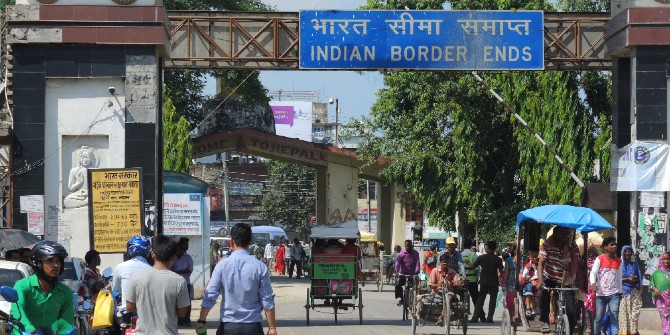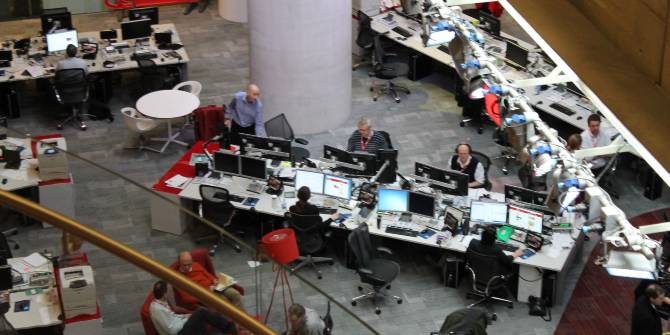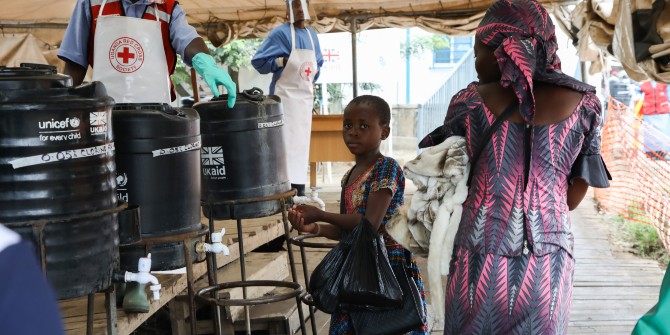Countries used pandemic restrictions to privilege or exclude migrants and foreigners, depending on their discretionary assessments of how useful or important those people were. Sin Yee Koh (Monash University Malaysia) looks at the emergence of new bordering tactics during COVID.
Borders and bordering practices have long been used by nation states to selectively include and exclude migrants and foreigners. This was no different in the era of COVID.
On the one hand, travel lockdowns hardened existing external borders, preventing inward and outward movement. Under the guise of health security, additional layers of internal and external borders emerged. This accentuated and complicated existing structures that stratified the already selective inclusion and exclusion of ‘others’.
On the other, in juggling pandemic control and economic recovery, some countries introduced new bordering tactics such as travel bubbles, green lanes, and fast lanes to spur the mobilities of those who were considered eligible.
These new and emergent borders and bordering tactics were used by state authorities in an attempt to manage and control the spread of the virus. Underlying them, however, were certain logics and assumptions about who should be protected, who should be kept away, and who should be allowed in or out, when and where.
The pandemic shed light on the enduring logics of injustice that inform existing and emergent borders and bordering tactics. As health security becomes intertwined with the governance of mobilities, we will see the emergence of new hierarchies of mobility deservingness. They have important political and ethical implications.
Borders: from lines to time-specific spaces
When thinking of borders, it might be easy to jump straight into using linear metaphors – lines that demarcate, walls that segregate, boundaries that include/exclude, partitions that divide, or gates that open/close. Regardless of which metaphors we use, the important thing about borders is that they perform these functions selectively.
The criteria – for inclusion/exclusion, entry/ non-entry, permission/restriction – are typically based on selective sets of requirements. These sets of selective criteria may vary across contexts and in time. During the pandemic, we saw rapid shifts in the development of new international travel restrictions and authorised entry on the basis of medical requirements and other conditions for selective groups of people (Figure 1).
Figure 1. COVID-related international travel restrictions (thousands), 8 March 2020 to 12 April 2021

Of course, none of this was new: borders and bordering tactics had been in use for a long time for different purposes – whether to selectively include/exclude certain groups, or to produce certain (economic/political) subjects. The pandemic, however, gave us more concrete examples of borders as spaces, in contrast to lines. For example, we saw the emergence of ‘travel bubbles’, also known as ‘travel corridors’ and ‘corona corridors’, as a kind of protected zone of travel – almost like a tunnel. These corridors were theoretically sealed from the point of origin to the destination as well as throughout the journey – including quarantine facilities at the destination. We also saw the emergence of ‘green lanes’, ‘fast lanes’, and ‘fast-track entry’ for less restricted travel depending on multilateral agreements.
What is interesting here is that the border became a space tied to a specific temporality. These bubbles and corridors existed only in a specific spatio-temporality (i.e. between an origin country and a destination country during a specified timeframe) created through the mutual agreement of the authorities involved. Some people were able to move from point A to point B with higher speeds, fewer hassles, and fewer additional costs – whether these were financial or opportunity costs. On the other hand, some mobilities were significantly slowed down, subject to multiple starts and stops along the way, suspended, or even entirely prohibited.
Shifting borders and enduring injustices
During the pandemic, there was no clear and universal answer to the question of ‘who gets in, … [who] gets out, and who gets rescued’
Ayelet Shachar has argued that the border ‘has become a moving barrier, an unmoored legal construct’ that is not fixed in place. Indeed, as the border becomes disentangled from a fixed locality, it attains spatial agility. Nevertheless – and perhaps because of this unfixed nature – the shifting border can be flexibly used to suit different purposes at different times. In this sense, the border becomes a method and a means to creatively and flexibly operationalise inclusion and/or exclusion.
Importantly, the shifting border has been rapidly expanding its reach beyond territorial confines. In the context of pandemic control, it offered nation states the ability to contain or keep out those deemed risky in order to protect those deemed worthy of protection. During the pandemic, there was no clear and universal answer to the question of ‘who gets in, … [who] gets out, and who gets rescued’ (original emphasis). We saw this fear of the potential enemy manifested in increased health and mobility surveillance, lockdowns resulting in selective im/mobilities, and deportations.
In this regard, the shifting border was ‘revived as a dispositif to protect the state from a virus that [had been] increasingly portrayed as a foreign invader’, in- and ex-territory.

It is here that the pandemic exposed enduring injustices based on structures of inequality such as race and class that were unequally shouldered by different groups. Those who had been marginalised and scapegoated in pre-COVID times (e.g. migrant workers or asylum seekers) were easily and uncritically turned into ‘enemies’. They were contained, detained, fixed in place, kept waiting, stopped in their tracks, and deported. Such bordering tactics imposed on the so-called ‘enemies’, however, disregarded the precarious conditions that made them more at risk to the virus in the first place. Bordering tactics also disregarded the medium- and long-term vulnerabilities that these groups faced, such as the risk of contracting COVID, lack of access to appropriate and affordable care, livelihood insecurity, stigmatisation, and discrimination. Regardless of prior and potential contributions to and membership of local and national communities, the migrant was made ‘disposable, subject to (even more) heightened security, and racialised as the source of pathogenic risk’.
By contrast, those not seen as enemies were allowed to move and to cross internal and external borders because they were not considered (health) security threats. As part of state strategies to revive national economies weakened by prolonged lockdowns, we saw nation states taking on a certain degree of calculated risk to partially reopen borders to certain groups. These included business travellers and investors, medical tourists, international students, and border commuters – groups who arguably had more capacities and resources to take on the additional (financial and time) costs of pandemic travel and whose mobilities had not been seriously curtailed, compared to the groups who were seen as ‘enemies’.
The bifurcated bordering tactics imposed upon ‘enemies’ and ‘non-enemies’ revealed ‘the underlying script states follow when they embrace or filter The Other’ (original emphasis).
New hierarchies of mobility deservingness
Putting aside legitimate public health considerations that might have justified the pandemic’s bordering tactics, it is important to recognise that the shifting border translated into material violence that positioned people in ‘new relations of power in political spaces of im/mobility’, as Shachar puts it. Indeed, it has been widely acknowledged that border control and migration governance have been inherently political, both during and before pandemic times. As health security becomes intertwined with the (political) governance of mobilities in the COVID era, I argue that we will be seeing the emergence of new hierarchies of mobility deservingness.
In their article on Malaysia’s healthcare regime, Meghann Ormond and Alice Nah wrote about ‘hierarchies of healthcare deservingness’ whereby migrants in Southeast Asia have been positioned on a hierarchy of differential access to healthcare largely on the basis of moral judgements. Parallels that can be drawn here. Those who were deemed fit for travel – that is, deserving of (risk-free) mobilities that did not compromise public health – were allowed to move. On the one hand, this is arguably a relatively objective judgement (i.e. health status on the basis of scientific measurements) in comparison to subjective moral judgements.
On the other hand, the seeming neutrality of its ‘objectiveness’ obscures pre-existing structures of inequality and inequity that might have contributed to an individual’s compromised health status in the very first place (e.g. differential access to housing, healthcare, nutrition, economic opportunities, networks, and information).
If the emergent hierarchy of mobility deservingness develops into an accepted norm, those positioned higher in the hierarchy will be able to enjoy greater access to mobility and opportunities to accumulate mobility capital. This capital can then be converted into other forms of capital in the future, locally as well as in another transnational locations. Unequal access to mobility capital, in turn, contributes to the exacerbation of inequalities as this new structure of inequity – mobility deservingness – overlaps and interacts with existing ones (e.g. race, class, and citizenship).
Concluding thoughts
This is not just a question of equity and justice for the current generation
In moments of crisis, great uncertainties, or a pivotal moment in history – like this pandemic – we are reminded that the rights and privileges accorded by nation states are highly discretionary. Status and access to rights and privileges are subject to changing circumstances and shifting state priorities. They are not – and cannot – be taken for granted. This applies equally to those of us who belong to groups of relative privilege (e.g. citizens, permanent residents, privileged migrants) as well as those of us who belong to groups of relative underprivilege (e.g. undocumented migrants). This is because, as borders shift, morph and mutate, we become positioned within these categories, sometimes without even realising it.
The development of new hierarchies of mobility deservingness is important because we know that migration and mobility are ways for people to achieve their aspirations, have a chance at attaining social mobility, or escape vulnerabilities. Furthermore, mobility has implications for residential status and citizenship acquisition later on or for the next generation. This is therefore not just a question of equity and justice for the current generation; it is also about that for future generations.
Acknowledgements
An earlier draft of this chapter was presented as an intervention at the ‘Migration and Mobility in the COVID-19 Era’ panel for the LSE Southeast Asia Week 2020. I thank Professor Hyun Bang Shin and the Saw Swee Hock Southeast Asia Research Centre for the kind invitation, the panellists (Dr Yasmin Y. Ortiga and Professor Johanna Waters) for their insightful interventions, and the audience members for their helpful questions. Thanks also to the International Organization for Migration for permission to reproduce Figure 1.
This is an edited extract from Koh, Sin Yee. 2022. ‘Emergent bordering tactics, logics of injustice, and the new hierarchies of mobility deservingness’. In: Shin, Hyun Bang; Mckenzie, Murray; and Oh, Do Young (eds) COVID-19 in Southeast Asia: Insights for a post-pandemic world. London: LSE Press, pp. 183–192. It represents the views of the author and not those of the COVID-19 blog, nor LSE.





